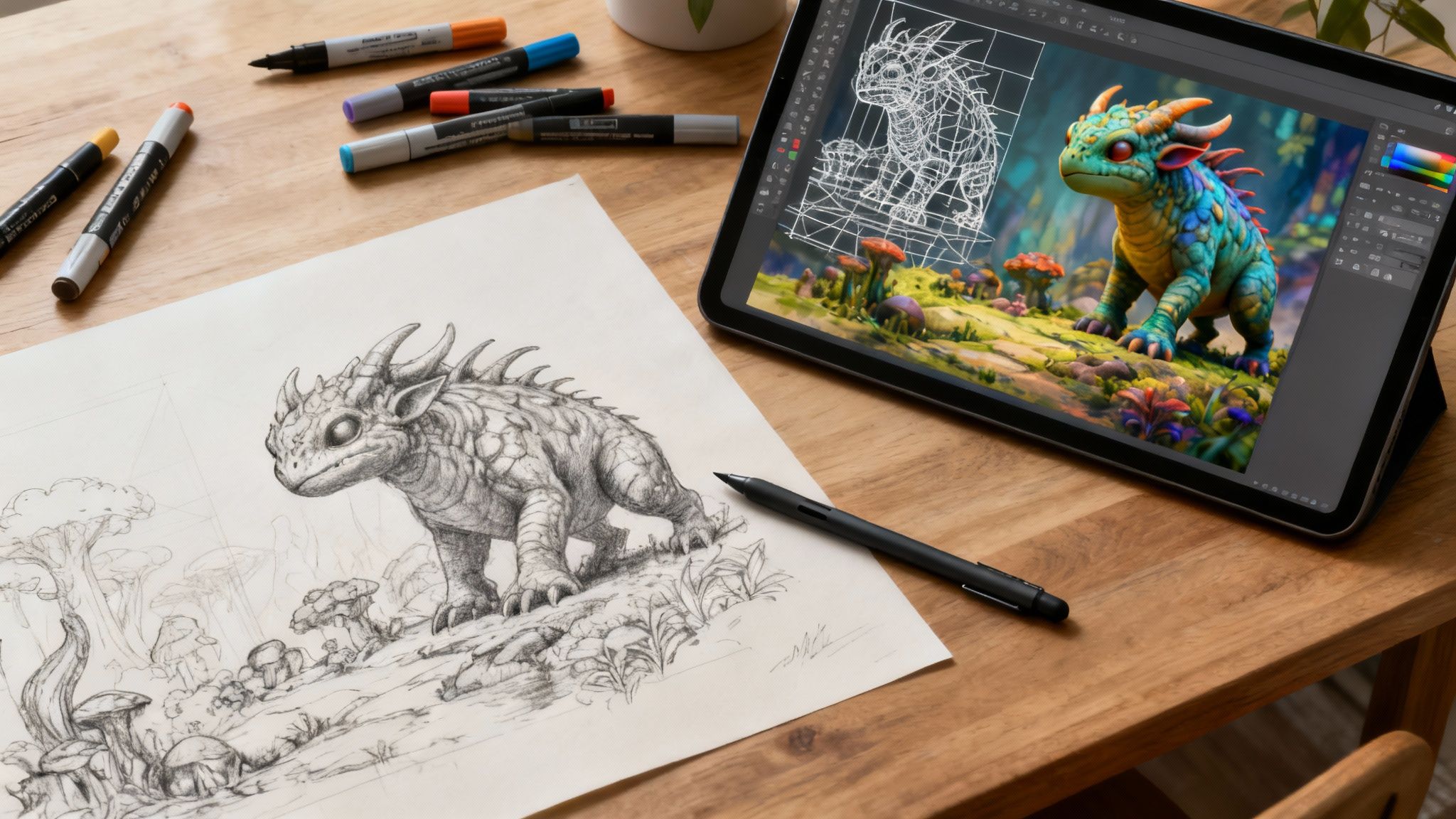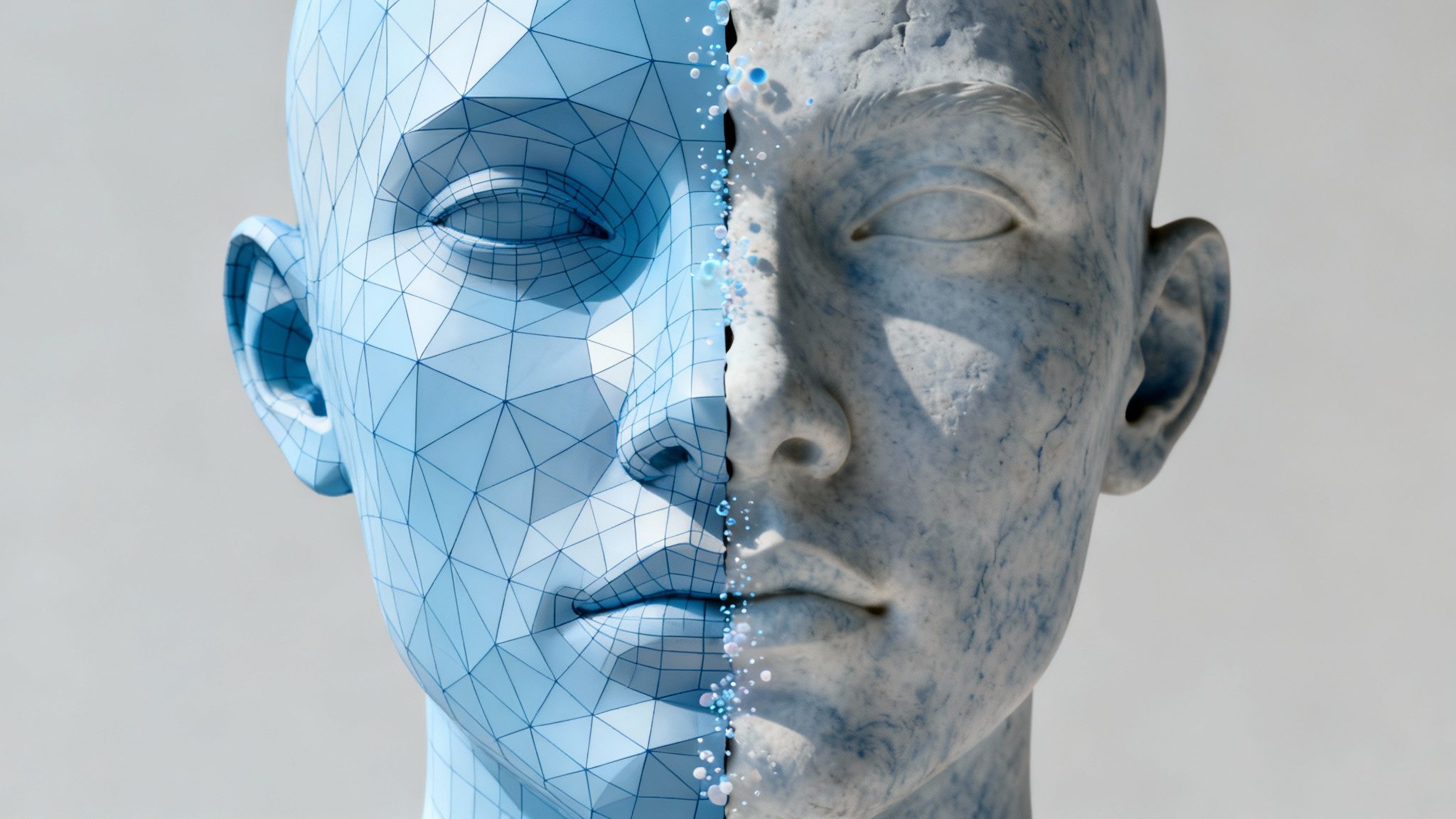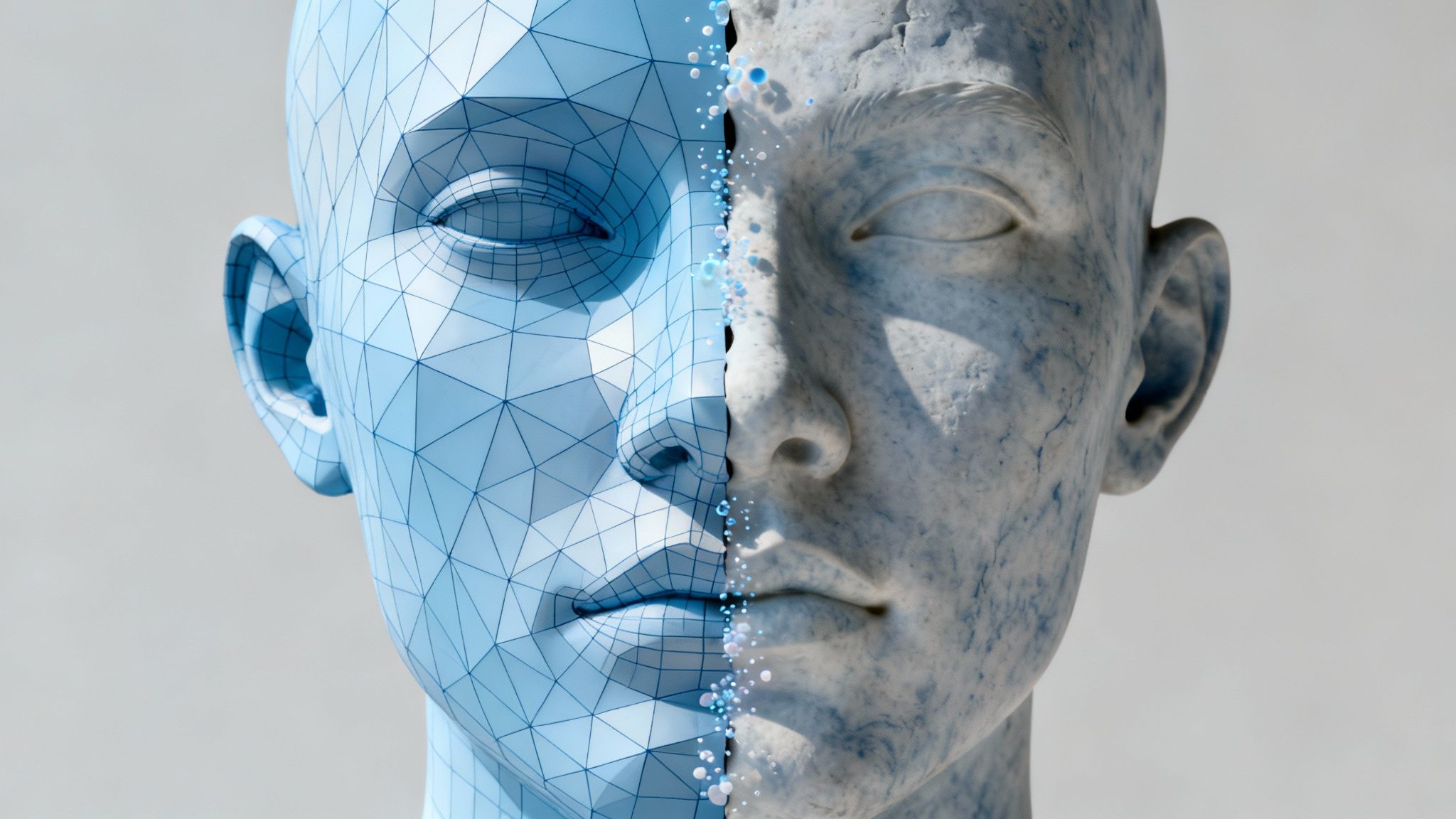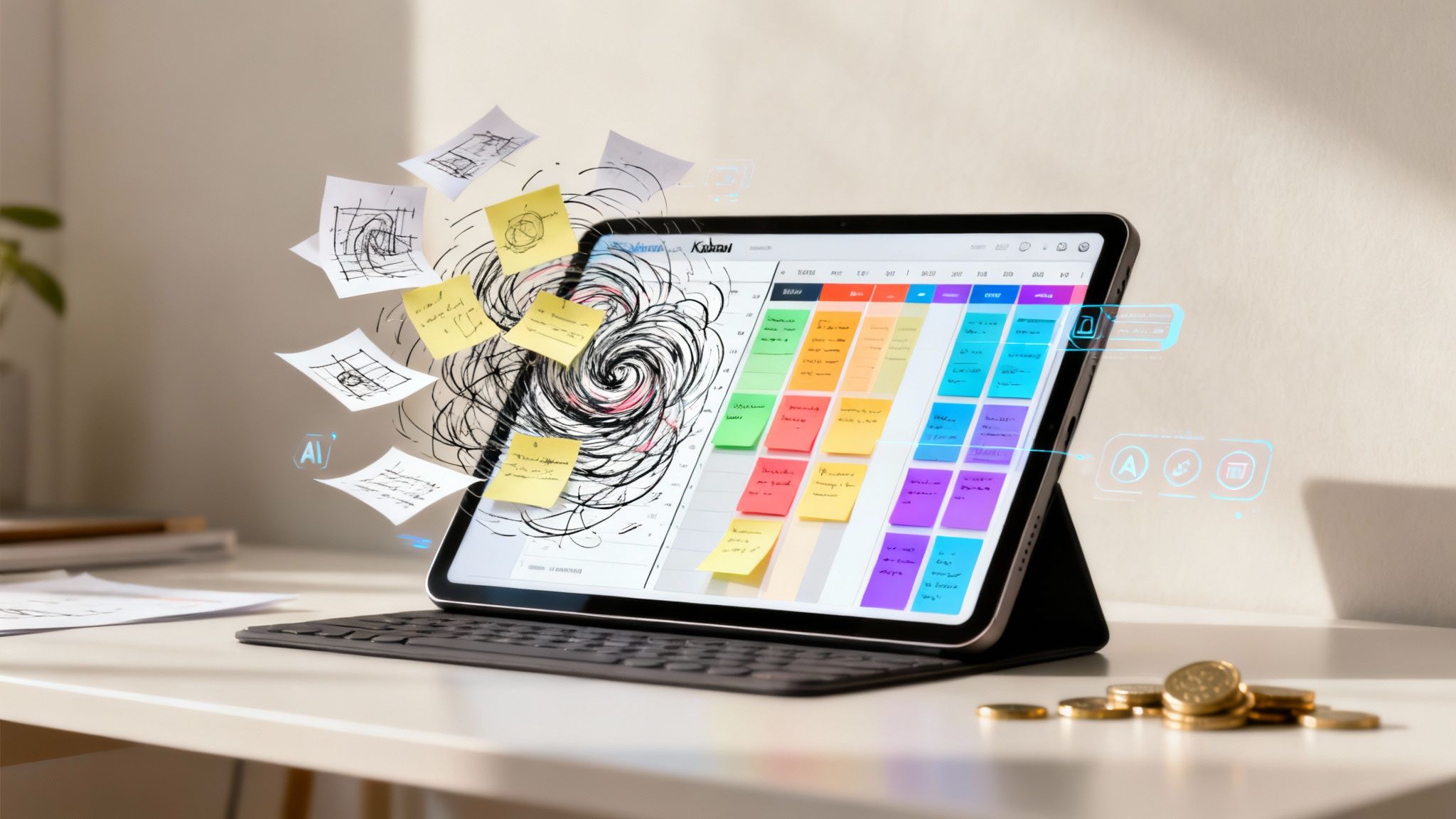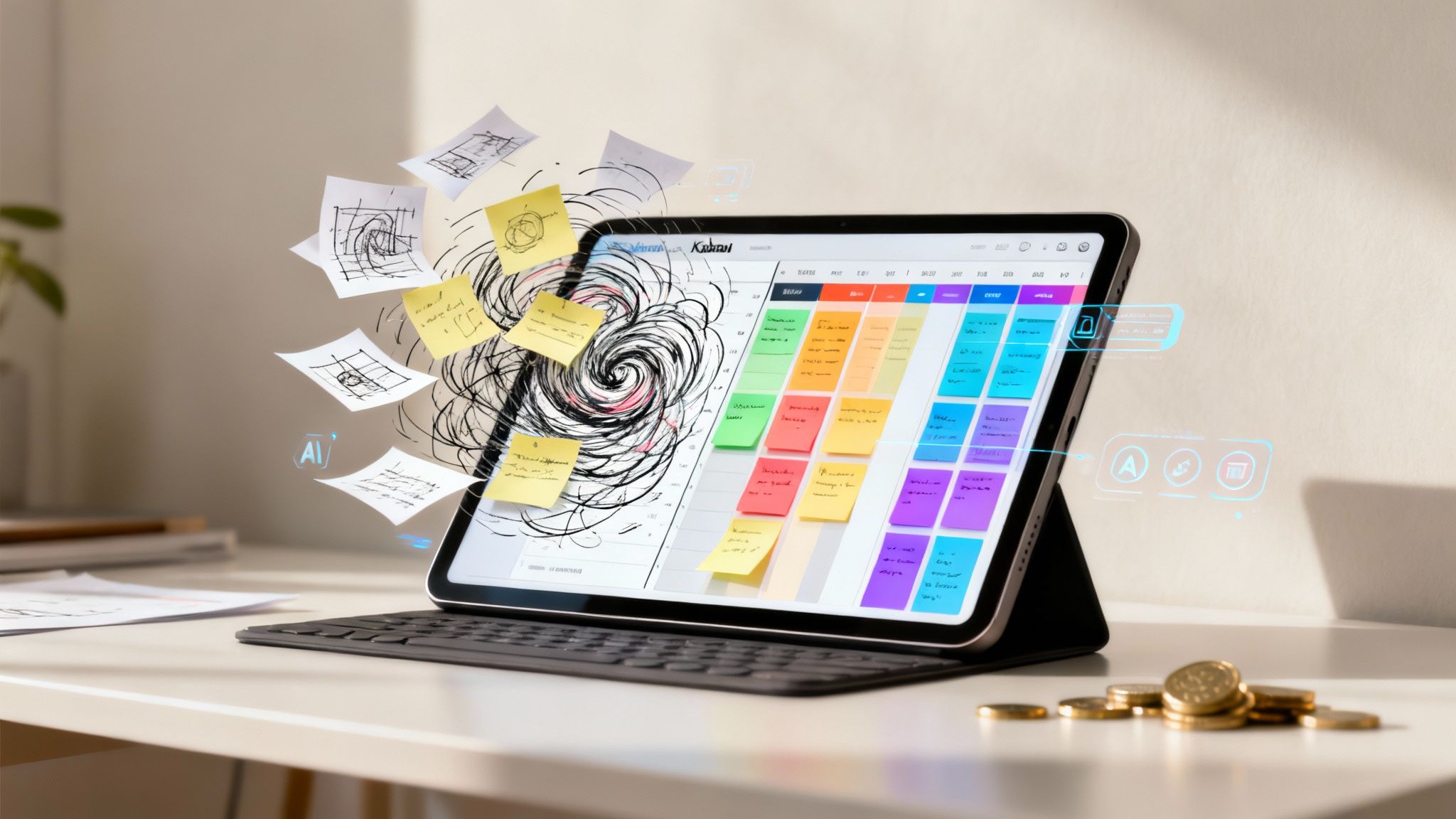Think of game concept art as the architectural blueprint for an entire digital world. Before anyone writes a single line of code, concept art translates abstract ideas into tangible visuals. It sets the stage for every character, environment, and prop you see on screen.
The Blueprint for Digital Worlds
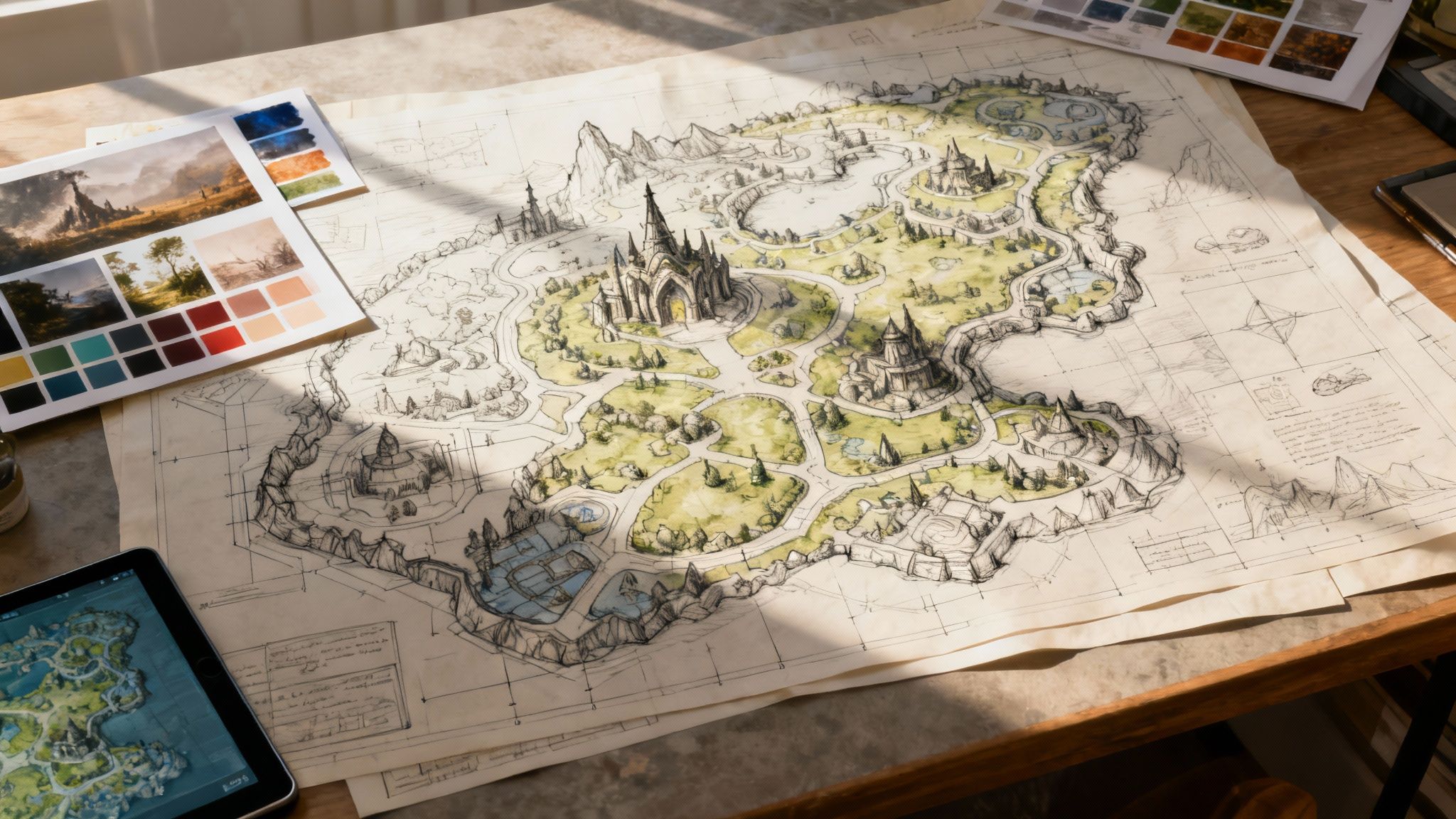
Game concept art is more than just illustration; it’s a strategic process that establishes a game's visual identity. This is the first step in determining what a game will look, feel, and play like. In this initial creative phase, abstract thoughts about story, mood, and gameplay are forged into a concrete visual language.
Imagine trying to build a house without a blueprint. Electricians wouldn't know where to run wires, and plumbers would have no idea where pipes should go. The result would be chaos. Concept art serves the same purpose for a game development team. It ensures everyone—from 3D modelers and animators to level designers and the marketing team—shares a single, unified vision.
This shared understanding is critical for preventing costly mistakes and extensive revisions down the line. It compels the team to answer vital questions before production begins:
- What is the overall aesthetic? A gritty cyberpunk city or a whimsical fantasy forest?
- How do character designs reflect their personalities and abilities?
- What architectural styles and technologies define the game’s environments?
- Does the visual style support the intended gameplay experience?
By tackling these points early, concept art becomes a crucial risk-mitigation tool. It allows teams to experiment with ideas quickly and cost-effectively, discarding what doesn’t work before significant time and resources are invested in building final assets.
More Than Just Initial Sketches
While the process often begins with rough sketches, game concept art evolves into a detailed visual guide. Artists create everything from broad "mood boards" that define the emotional tone to specific design sheets detailing a character's costume from every angle. This work establishes the visual rules of the game's universe.
A key objective is to establish a strong "readability hierarchy." This ensures players can instantly differentiate between a common enemy and a powerful elite based solely on their design. This form of visual communication is essential for intuitive and satisfying gameplay.
This art doesn't just inform the final look; it shapes the functional parts of the game as well. For instance, the silhouette of a long-range enemy might be designed with a distinct backpack or antenna. This makes it identifiable from a distance—a critical piece of tactical information for the player during gameplay.
The Foundation of the Player Experience
Ultimately, the impact of game concept art extends directly to the player. It shapes their first impression, establishes the world's believability, and helps forge lasting emotional connections. The global video game industry is a massive market, and concept art sits at the forefront of this creative and economic engine.
It defines the visual identity and aesthetic appeal of games before development truly begins, which directly influences player engagement and commercial success. You can discover more insights about the gaming industry's scale and its key drivers. This foundational art ensures every visual element works in harmony to build an immersive and memorable world that players want to explore.
The Core Pillars of World-Building
Effective game concept art is built on a foundation of three distinct but deeply connected pillars: Characters, Environments, and Props. Together, they form the visual DNA of a believable and immersive world.
Consider the analogy of building a movie set. You need compelling actors (characters), a convincing location (environment), and all the items they interact with (props). If one piece feels out of place, the entire illusion can be compromised. Concept artists are the architects ensuring every element not only looks compelling but also feels cohesive.
Everything is interconnected. A character’s design is shaped by the world they inhabit. The props they carry convey information about their role, personality, and the technological level of their society. Let's examine how each pillar contributes to the whole.
Breathing Life into Characters
Character concept art is a form of visual storytelling. An artist must communicate a character's personality, backstory, and role using only their appearance. This involves exploring silhouettes, color palettes, and gear to create figures that are instantly recognizable and understandable to the player.
A major part of this is establishing what is known as a "readability hierarchy." In the midst of gameplay, players need to identify their opponents in a split second.
- Horde Enemies: These are typically designed with simpler, uniform looks to feel like a single, overwhelming force.
- Elite Enemies: They receive clear visual upgrades—such as unique armor colors or more prominent weapons—to signal a greater threat.
- Special Units: These characters are given truly unique silhouettes. A bomber might have a large backpack, or a sniper might have a long rifle that breaks their profile, allowing players to spot the danger from a distance.
An excellent example comes from Warhammer 40,000: Darktide, where artists found that focusing design details on the head and shoulder area made the most significant difference in player recognition. This insight helped make elites and specials stand out in hectic combat, directly improving the gameplay experience.
Crafting Worlds That Tell Stories
Environment art sets the stage. This is the art of designing the worlds players explore, from sprawling sci-fi cities to ancient forests. These spaces are not just backdrops; they are active storytellers, built to evoke feelings of awe, tension, or wonder.
Environment artists think like a combination of architect, historian, and cinematographer. They consider everything from the large-scale layout of a level down to the weathering on a single brick. This attention to detail is what makes a world feel lived-in and real, inviting players to become fully immersed. The process often involves painting over early 3D "whitebox" layouts to give level designers a clear guide for mood, lighting, and visual flow.
Adding Authenticity with Props
Props are the unsung heroes of concept art. These are the thousands of individual objects that populate a game world, from a hero's iconic sword to the coffee cups on a desk. They may seem small, but props add layers of detail, function, and narrative.
A well-designed prop does more than just fill space; it tells a micro-story. An abandoned campsite with a still-smoldering fire suggests someone was there moments ago. The design of a futuristic rifle can explain the technological level of a society without a single word of dialogue.
Every object helps sell the reality of the world, making it feel tangible. And with new technologies, artists can explore variations faster than ever. You can learn more about the role of AI in game development to see how these workflows are evolving.
From Sketch Pads to Digital Canvases
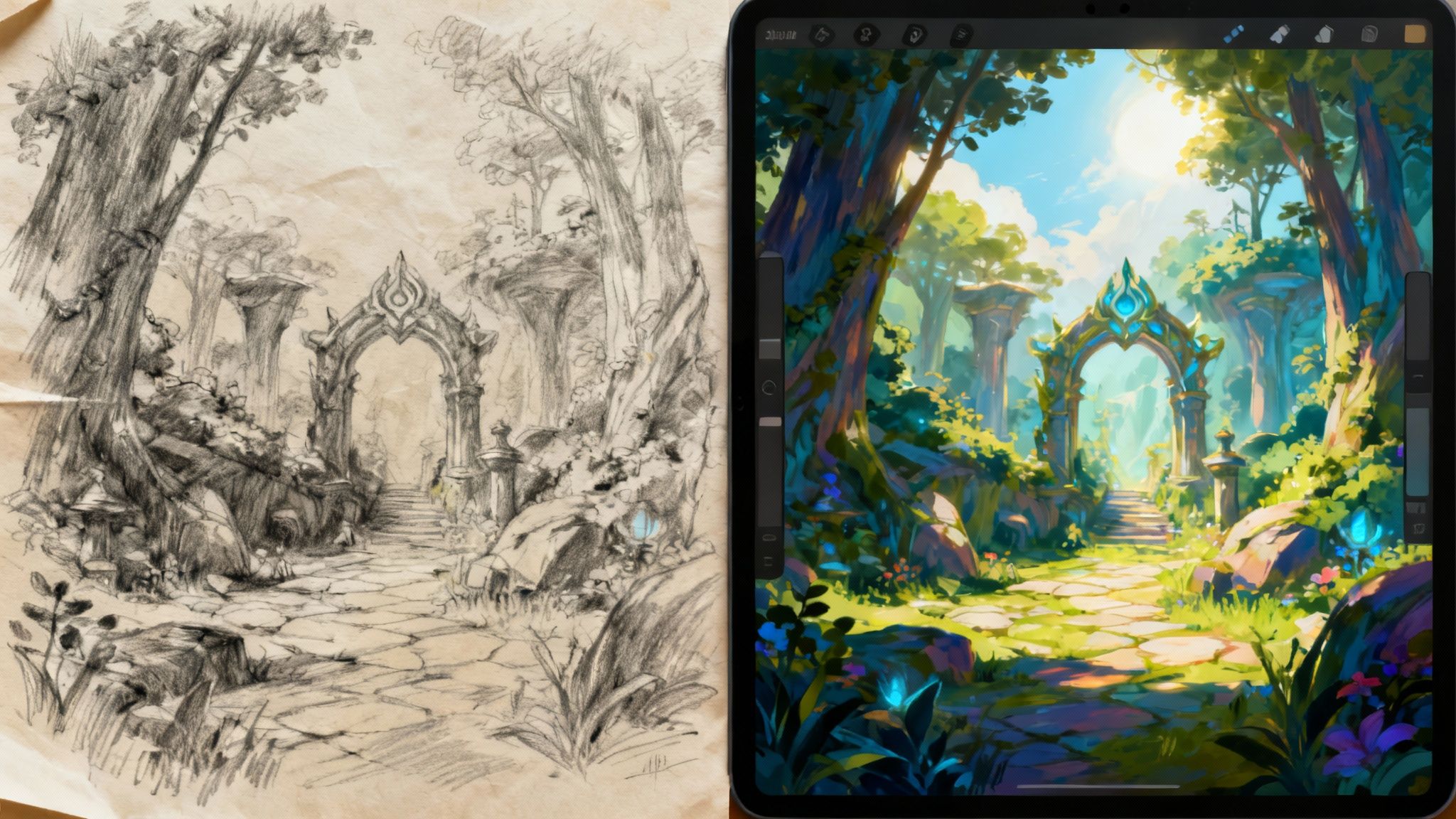
The history of game concept art is intertwined with the story of technology. As tools became smarter, faster, and more powerful, creative possibilities expanded alongside them. What began with analog methods has evolved into a sophisticated digital workflow that continues to push creative boundaries.
In the early days of game development, everything was analog. Artists relied on pencil, ink, and paint to sketch the characters and worlds that would become pixelated classics. These physical drawings were the blueprints and the single source of truth for the pixel artists and modelers who followed.
The landscape changed dramatically in the mid-1990s. The arrival of digital tools like Adobe Photoshop was not just a new feature; it was a revolution that completely reshaped the production pipeline. This leap offered artists incredible speed, flexibility, and the advantage of non-destructive editing. You can read more about how digital tools shaped modern art and the trends that initiated this new era.
The Digital Revolution in Game Art
Moving from canvas to screen was about more than swapping paint for pixels—it was a fundamental shift in how artists worked. Suddenly, it was possible to experiment with color palettes, tweak compositions, and adjust lighting in ways that were impractical with physical media. The ability to work in layers and use an "undo" function reduced the fear associated with creative risks.
This new digital workflow introduced significant advantages that are now standard practice:
- Rapid Iteration: Artists could produce dozens of variations for a character or environment in the time it once took to create a single physical piece.
- Seamless Collaboration: Digital files could be sent to 3D modelers and animators in seconds, tightening the feedback loop and aligning the team more quickly.
- Enhanced Precision: The power to zoom in and work at a pixel level gave artists a degree of control and detail that was difficult to achieve consistently by hand.
This period cemented Photoshop as the industry standard, and the digital painting skills developed back then remain the bedrock of a concept artist’s toolkit today.
The introduction of digital tools didn't just make the old process faster; it fundamentally changed creative thinking. Artists began exploring more complex designs because the cost of experimentation dropped to nearly zero.
Integrating 3D into the Concepting Phase
The next major advancement was bringing 3D tools directly into the initial concepting phase. Software like Blender, ZBrush, and Maya—once reserved for final asset production—became powerful sketching tools in their own right. This has been a transformative development.
Instead of starting with a 2D sketch, many artists now "block out" a character or environment with simple 3D shapes first. This 3D foundation establishes correct perspective, scale, and lighting from the outset. From there, they can take a render or screenshot of their 3D scene and paint over it in 2D, adding rich details, textures, and atmosphere.
This hybrid 2D/3D approach is highly effective. It helps solve complex design problems early, ensuring a concept that looks great in 2D will also work as a functional 3D model. It also builds a much stronger bridge between the concept and production teams, since the initial 3D blockout can often be handed directly to modelers as a starting point. This technical fluency is now a highly sought-after skill, making the concept artist more integrated into the production process than ever before.
A Modern Concept Artist's Digital Toolkit
Step into a modern game studio, and you'll find the concept artist's desk is a blend of creative vision and advanced technology. The days of pure pen and paper are largely gone. Today's artists are digital craftspeople, armed with a powerful suite of software that enables them to build worlds faster and with more precision than ever before.
The right toolkit isn't just about speed; it's about expanding possibilities. At its heart are two core disciplines that work in tandem: 2D illustration and 3D modeling. These are no longer separate jobs. The most effective artists move fluidly between them, using each to solve different problems and bring their ideas to life.
The Foundation in 2D Software
The digital canvas is still where most ideas begin. 2D software is the bedrock of concept art, giving artists the freedom to sketch, paint, and iterate without limits. It's the modern equivalent of an infinite supply of brushes, paints, and paper.
For professional work, a few tools are indispensable. They provide the raw power and control needed to create polished illustrations that guide the entire art team.
- Adobe Photoshop: The long-standing industry leader in digital painting. Its comprehensive brush engine, deep layering system, and powerful editing features make it essential for everything from rough thumbnails to final, marketing-ready art.
- Procreate: A popular choice for artists who value an intuitive, mobile workflow. Running on an iPad, it offers a natural drawing feel, perfect for sketching ideas wherever inspiration strikes.
- Clip Studio Paint: A favorite among character artists and illustrators for its excellent line art tools and brush stabilization. It is a strong option for creating detailed character sheets or comic-style art.
These tools are where the project’s mood, color, and fundamental design language are established before moving to more complex 3D work.
Expanding Possibilities with 3D Tools
The most significant change in recent years has been the integration of 3D into the concept pipeline. What was once exclusively for production modelers is now a core part of the initial creative phase. 3D lets artists quickly block out shapes, test lighting, and establish perspective before committing hours to a detailed painting.
This hybrid workflow is often called a "3D block-out" or "kitbashing." An artist will build simple 3D shapes to establish a scene's composition, render it, and then paint over the top in 2D to add detail, texture, and atmosphere.
This approach saves a massive amount of time and guesswork. It provides work with a solid, believable foundation, ensuring buildings are structurally sound and characters appear correct from every angle.
- Blender: A free, open-source powerhouse that has become a staple in the industry. It can handle sculpting, modeling, and rendering, making it an incredibly powerful and accessible tool for any concept artist.
- ZBrush: The industry standard for digital sculpting. For creating hyper-detailed organic shapes like characters, creatures, or intricate environmental assets, ZBrush’s clay-like workflow is unparalleled.
- Keyshot: A simple yet powerful rendering engine that lets you create photorealistic images of models quickly. It’s perfect for presenting prop designs or vehicle concepts with professional materials and lighting.
To make sense of it all, here is a quick comparison of the most common tools in an artist's arsenal.
Essential Software for Game Concept Artists
This table breaks down the go-to applications, their primary use, and their typical learning curve.
Ultimately, success is not about mastering just one tool, but about building a flexible workflow that allows you to select the right software for the job at hand.
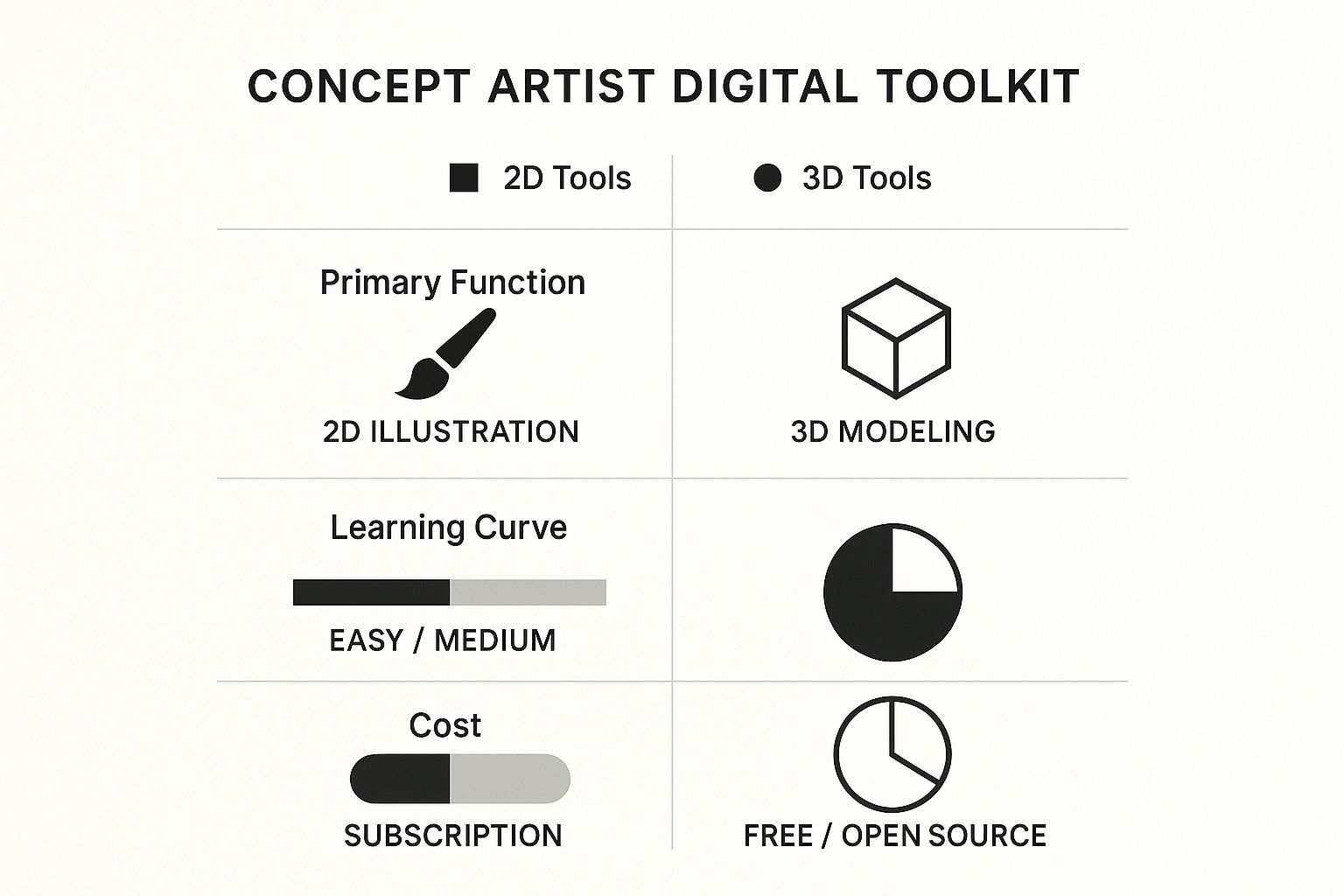
As the infographic shows, 2D tools are often easier to begin with, but adding 3D skills opens up a new level of technical and creative capability. Now, a new layer is being added with generative AI. For those curious about how that's changing the landscape, you can review this curated list of AI tools for designers to see what's on the horizon.
How AI Is Shaping Creative Workflows
Artificial Intelligence is quickly becoming a valuable partner in game concept art. The conversation is not about replacing artists, but about providing them with powerful tools for ideation, iteration, and rapid prototyping.
This shift allows teams to explore more creative avenues than ever before. When used responsibly, AI can be an incredibly efficient assistant. It can generate dozens of variations on an idea in minutes—a task that would take a human artist hours or days. That speed fundamentally changes the early stages of development.
Accelerating Ideation and Prototyping
Imagine a character designer needs to develop a new suit of armor. Instead of sketching ten different versions, they can prompt an AI to generate fifty base designs in the time it takes to get a coffee.
The artist then acts as a curator, blending the best elements and adding their professional touch to finalize the concept. Their role shifts from pure generator to creative director, guiding the AI and making high-level artistic decisions.
This workflow is a significant advantage for:
- Costume Variations: Instantly generating different armor sets, sci-fi suits, or fantasy robes.
- Color Palettes: Testing numerous color schemes to find the perfect mood for an environment.
- Base Textures: Creating foundational textures for props that can be refined by hand.
AI can handle the high-volume, repetitive work of early ideation. This frees up artists to focus on what matters most: storytelling, emotional impact, and the final polish that makes a design memorable.
It is also an effective way to overcome creative blocks. A blank canvas can be intimidating, but a screen full of AI-generated starting points provides something to react to and build upon.
Compliant and Secure Enterprise Use
For professional studios, adopting AI responsibly is paramount. The focus is on secure, compliant tools that respect data privacy and intellectual property. Modern enterprise-grade AI platforms are designed to operate in a controlled environment, ensuring a studio's proprietary assets and data remain confidential.
The primary benefit for businesses is a massive boost in efficiency. A small team can increase its creative output, exploring a visual territory that was once only possible for a much larger studio. This is especially true with real-time AI, which offers instant visual feedback. You can learn more about how real-time AI is changing creative industries and what it means for production.
The technology is also moving beyond static images. We are now seeing latest advancements in video generation with Sora 2, which can create cinematic elements that serve as valuable reference or inspiration for concept artists.
AI as a Creative Partner
The most effective way to view AI in game concept art is as a collaborator. It is a tool that excels at generating breadth, allowing the human artist to provide the depth, context, and creative soul that technology cannot replicate.
This partnership encourages a more experimental workflow. Artists can take greater creative risks because the cost of failure is almost zero. If an idea doesn't work, only a few moments of generation time are lost, not days of effort.
That freedom can lead to more surprising and original designs—and ultimately, to richer, more visually stunning game worlds.
Your Questions About Game Concept Art Answered
Entering the world of game concept art can feel complex. Whether you're an artist looking to enter the industry, a developer, or simply a curious gamer, you likely have questions.
This FAQ section provides a set of signposts to clarify the skills, career paths, and the critical role this art form plays in the games we enjoy.
What Are the Must-Have Skills for a Concept Artist?
Success in this field requires a blend of artistic talent and strong technical skills. While every artist has a unique style, a few skills are non-negotiable for professional impact.
The most important is a firm grasp of art fundamentals. There is no substitute for a deep, practical understanding of:
- Anatomy: Essential for creating believable characters and creatures.
- Perspective: This makes environments and props feel grounded and real in a 3D space.
- Composition: Knowing how to arrange a scene to guide the viewer's eye and tell a story is key.
- Color Theory: This is how you create mood, evoke emotion, and ensure a cohesive visual world.
Beyond these classic pillars, fluency with the tools of the trade is required. This means being proficient with industry standards like Adobe Photoshop and, increasingly, 3D software such as Blender. The ability to move between 2D and 3D workflows is no longer just a bonus—it's what studios expect.
What Does a Typical Career Path Look Like?
Most artists begin their careers in a junior or associate role. In this position, you'll work under a senior artist or art director, handling smaller, well-defined tasks like individual props, costume variations, or specific environmental details. It’s where you develop your skills, learn the studio's pipeline, and demonstrate your reliability.
With experience, you can advance to a mid-level or senior concept artist. At this stage, you are trusted with larger and more critical pieces of the project, such as designing a key hero character, setting the mood for an entire level, or creating "keyframe" illustrations that capture a pivotal story moment.
The pinnacle for many is becoming a Lead Concept Artist or an Art Director. In these leadership roles, the focus shifts from creating the art to guiding it. The job involves defining the project's entire visual direction, mentoring other artists, and maintaining the game's aesthetic integrity.
This progression isn't just about becoming a better painter. It's about sharpening your design sense, mastering communication, and learning to translate abstract gameplay ideas into compelling visuals that inspire the entire team.
How Much Does Concept Art Really Impact the Final Game?
The impact is massive. Concept art serves as the visual DNA of the final game. It is the blueprint the entire production team—from 3D modelers to animators to level designers—uses to build a cohesive and unified world.
Consider a character's concept art. It is more than just a drawing; it defines their personality, equipment, and function in the game. An effective enemy design has a clear silhouette that players can instantly identify in the middle of a chaotic fight—a crucial gameplay element known as "readability." A character artist on Warhammer 40,000: Darktide noted how focusing design details on the head and shoulders was key to helping players spot different enemy types at a glance.
The same applies to environments. Concept art establishes the mood, lighting, and architectural language that makes a world feel alive and consistent. Without that solid foundation, a game would feel like a disjointed collection of assets. The concept phase is where the soul of the game begins to take visual form.
Ready to unify your team's creative workflow? Virtuall provides an all-in-one Creative OS where you can generate, manage, and collaborate on 3D models, images, and videos. Streamline your production from concept to final asset today.


